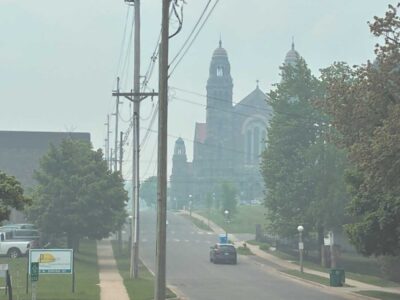Escanaba working on master plan

By R. R. Branstrom
rbranstrom@dailypress.net
ESCANABA — Along with an outside consultant, the City of Escanaba — the largest municipality in Delta County and the third most populous city in the Upper Peninsula — has been working on developing a new master plan.
Though not a binding document, a master plan is policy guide meant to inform future decisions for a community. It’s one of the projects of a city’s planning commission and often hired experts who analyze a number of factors.
“The planning process begins with a study of existing conditions, including demographics, housing, transportation, economic trends, or other analyses. The public is then engaged to give input how they want the community to grow over the next 20 or more years,” states the Michigan Chapter of the American Planning Association.
A master plan is important because it is consulted by the community’s planning commission when new proposals come before them. If a corporation comes to Escanaba and wants to buy property to open a store, or if a developer wants a certain plot of land rezoned so that they can build an apartment complex, the commission must ask itself: “Is this proposal in line with our master plan?”
Though one plan can serve for up to 20 years with adaptations, the State requires that it be reviewed at least every five years. The Michigan Economic Development Corporation (MEDC) even recommends an annual review.
Before the City of Escanaba began seeking an overhaul recently, its last master plan had been published in 2016.
Last spring, Escanaba put out requests for bids on the job of developing a new master plan. A planning firm from downstate called Beckett & Raeder won out, and the city council agreed to hire them in June of 2024 for a cost of just below $50,000 — all of which comes from grant money, not city funds.
An early step in the process was to poll the residents and frequent visitors of Escanaba. From Aug. 19 to Nov. 11, an online survey was made available so that local needs and desires could be considered. Some of the questions it asked were: “In terms of commercial and industrial development in Escanaba, what is working well?” and “As Escanaba continues to evolve, what is important to preserve?” and “What type of housing is needed in Escanaba?”
The planning commission was hoping for 500 responses. They got 411. Unfortunately, it wasn’t a broad sample — the responses came heavily from higher-income persons who own their homes. Since that does not correlate with what is known about Escanaba’s demographics (from data gathered buy the United States Census Bureau and American Community Survey), it means that certain sections of the population did not make their voices heard.
87.2% of survey-takers said they own their own home, but only 58.6% of housing units in Escanaba are occupied by owners. 32.7% of survey-takers were between 45 and 54 years old, but only about 15% of the city’s population falls in that age range. 63.8% of survey-takers reported an annual household income of over $75,000, while only 23.5% of Escanaba households make that kind of money.
This means that lower-income residents and renters in Escanaba did not report their wants, and the planners are left to speculate.
Such a turnout is not uncommon, however. When surveys are aimed at mass areas, responses tend to come from older, higher-earning, more highly-educated individuals.
The reasons for this are unclear and probably varied. Though Escanaba’s master plan survey was advertised on the city’s website, in the newspaper and on televised news, many people don’t interact with those sources. Perhaps mailers sent to everyone’s doors would have gathered better cross-sections — or perhaps not. Many people are simply distrustful of government or believe that their input won’t make a difference.
Citizen engagement can and often does have impact, though. In this case, it’s an important step in the process.
“Public input ought to set… our goals and expectations,” said Escanaba Planning and Zoning Administrator Joseph Walker. “We know a lot of what the city needs, I think, but what residents want is extremely important when we look to the future and form this master plan.”
In another effort to garner more community engagement, the city hosted this May a “charrette,” an open house-type event that invited citizens to city hall to engage with each other and city planners. The event featured questions on easels around the room and asked attendees to tack up responses written on sticky notes.
Besides just survey questions, the posterboards also displayed information for context. That way, people weren’t blindly answering what they thought a reasonable price of rent was; they were shown figures and facts that provided context.
“I think presenting that data more clearly during the charrette, alongside information showing how rent-burdened our residents are and that 80% believe housing is too hard to find, helped make the issue feel more real and immediate,” said Walker.
Attendees of the charrette said that they would like to see more of all types of housing, from single- and multi-family houses to apartments, townhomes and tiny homes.
“Residents want to see more housing that can be affordable to average residents, with a lot of support for more denser units as well as expanding support for accessory dwelling units (in-law suites),” said Beckett & Raeder Project Planner Alex Wilkinson after the charrette. He noted that the capacity for older residents to be able to age in place was also requested.
People also want to see more businesses and industry in Escanaba. They want more places to shop and dine downtown, plus “another large employer in the event that Billerud leaves in the future,” as one person wrote.
“In a conversation with one of the attendees, they mentioned how jobs in the UP do not pay as well as similar jobs in other places. This has led to many younger residents moving away to seek perceived better opportunities,” Wilkinson said.
Walker believes that the “central issue” creating the other problems is the housing crisis.
“It can take a lot of work and marketing for a city to attract certain businesses, but it’s much easier when the city already has the demand and workforce to support them,” he said.
“We have more levers to pull at the local level to promote the addition of housing than we do for, say, attracting a new industry. That’s why I’m encouraged to see the charrette responses so clearly supporting a wide variety of new housing … options like duplexes and triplexes, which can blend well into existing neighborhoods, and larger multifamily developments, for which we have several strong vacant sites,” Walker continued. “I also think there’s significant opportunity to add density or renovate existing housing downtown, which could breathe new life into the area and bring in more customers for our local businesses.”
Of course, the practicality behind putting various pieces together to solve all of Escanaba’s perceived issues is a complex, many-layered beast, and solutions won’t be easy or fast.
“A large barrier to accelerating housing growth is the lack of skilled tradesmen to work — plumbers, electricians, etc. Find a way to (incentivize) getting the workers it will require,” someone wrote on a note at the charrette.
“City needs to demonstrate proactive efforts. … We have to stop thinking of community plans as ‘wish lists.’ If we stay in that rut, we’ll never make any progress,” wrote another.
Finding the right balance of new growth may be tricky, too.
“Attendees also mentioned that while they want to see development, they want it to be thoughtful and don’t want anyone to ‘Traverse City our Escanaba.’ While they do want increased visitorship to provide more year-round living wage positions, they don’t want the city to become over-commercialized,” Wilkinson said.
City features that were cited by residents as in need of being preserved were the waterfront, parks and recreational spaces, historic structures and cultural offerings.
Work on the City of Escanaba’s new master plan is ongoing, and development is always happening. Anyone interested in observing operations of the city planning commission may attend their public meetings in the council chambers of city hall at 6 p.m. the second Thursday of each month — though July’s was rescheduled to the 24th. There is* also a vacancy on the board; persons interested in serving on the planning commission may apply at the city clerk’s office within city hall or online at escanaba.org/bc.
0





